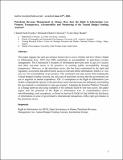Petroleum revenue management in Ghana : how does the right to information law promote transparency, accountability and monitoring of the annual budget funding amount?
Abstract
This paper engages the open governance framework to assess whether and how Ghana's Right to Information Law, 2019 (Act 989) contributes to accountability in petroleum revenue management. The Constitution's freedom of information provision aims to get civil society and other non-state actors to be proactive in exerting public accountability through transparency. However, in the petroleum sector, this has been constrained by the legal and regulatory ecosystems that affect timely access to relevant public information, which is a ‘sine qua non’ for accountability in governance. This constrains non-state actors from tracking the Annual Budget Funding Amount, the only part of petroleum revenue that the government can use to augment its annual expenditure. The 13 exemptions in the Right to Information Law further compound the opacity in the petroleum sector and showcase the ambiguity surrounding the government's commitment to open governance. Adopting the Kantian Publicity Principle as a change pathway and using examples of the setbacks faced by non-state actors, this paper argues that the potential of the Right to Information Law to counterbalance power notwithstanding, such exemptions, as found in Section 8(1)(d)(i-ii) that forbids the disclosure of information on some of government's international transactions, stifles open governance in the petroleum sector.
Citation
Sefa-Nyarko , C , Okafor-Yarwood , I & Boadu , E S 2021 , ' Petroleum revenue management in Ghana : how does the right to information law promote transparency, accountability and monitoring of the annual budget funding amount? ' , Extractive Industries and Society , vol. 8 , no. 3 , 100957 . https://doi.org/10.1016/j.exis.2021.100957
Publication
Extractive Industries and Society
Status
Peer reviewed
ISSN
2214-790XType
Journal item
Collections
Items in the St Andrews Research Repository are protected by copyright, with all rights reserved, unless otherwise indicated.

